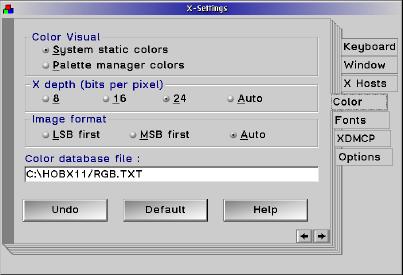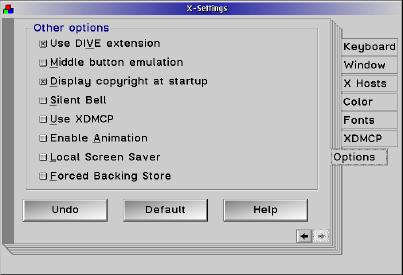
VOICE Home Page: http://www.os2voice.org
[Newsletter Index]
[Previous Page] [Next Page]
[Feature Index]

VOICE Home Page: http://www.os2voice.org |
April 2002
[Newsletter Index]
|
| By Jeremy Workman © April 2002 |
HOBLink is a "X-Server" that can enable you to run applications that
require XFree86 (aka the X Windows System.. typically found on Linux and UNIX operating
systems). HOBLink X11 allows you to use these apps without installing the OS/2 version
of XFree86. XFree86 only runs in full screen sessions, so you can't access other
PM applications. While HOBLink runs each app in a separate window so it doesn't
cover up your WPS.
In this article I'm going to go over how I'm using HOBLink to make my life easier.
In the past I had considered installing XFree86/2, but always decided against it.
I never liked the idea of covering up my OS/2 desktop. We all know that the WPS
is one of the best things about OS/2. I am a user of multiple operating systems.
When I needed to run a program that I couldn't have in OS/2 I would boot Linux.
I recently installed HOBLink X11, which comes with eComStation. Now I had a couple
options. I could install required libraries and executables from the XFree86 packages
and run applications that have been ported to OS/2 (which is limited). The second
option being to run the applications from my Linux machine.
I decided to try running applications from the Linux machine, and I'm glad I
did. I know, to some of you who maybe reading this you're probably thinking that
this isn't going to be an easy task. It turned out to be much easier than I expected.
HOBLink didn't require any special settings. Just general settings for video.
Here you want to choose your color depth. You would choose the color depth you
are using in OS/2. In the "Image format" field I choose to use the Auto
setting since I wasn't quiet sure about it.

I had to select "Use DIVE extensions" before apps would display correctly
on my machine. It's supposed to work okay without this option, so you may or may
not need it. If you only have a two button mouse you will need to select "Middle
button emulation". Three button mice are very useful under Linux, it will allow
you to Paste by clicking the middle button in X applications. The middle button
emulation works similar to the way you can click on the OS/2 desktop to call a Window
List (hold in left, tap right).

As far as I know, settings besides the ones I mentioned above can be left at
the defaults. Now you will need to login to the Linux machine with a Telnet client
(ssh, or whatever you use). I like to use EmTec's Zoc, it has some nice features
that I would rather not do without such as; being able to scroll up (Shift+PageUp),
and you can keep an address book.

Now we need to tell the Linux machine that programs we execute are to display
on the OS/2 machine. At the shell we want to send a command something like this:
export DISPLAY=os2box.local.ip.address:0
![]()
That is pretty much all there is to it. Now you can run just about any XFree86
application you want.
A couple valuable tips that I suggest you use is 1) when you launch a program
add a "&" at the end. This allows you to launch the program without
tying up the shell, so if you need you can run more applications. 2) Some programs
may send annoying output to the shell, to prevent this when you run the app you
can send it's output to /dev/null.

Here is a screenshot to give you a idea of how it
looks.
Of course there are still some limitations. You have to remember that these programs
are only being displayed on the OS/2 desktop. Therefore programs that 1) use sound
will use the sound card in the Linux machine. 2) When saving your work you can only
save it to the drive in the Linux machine (unless you have file sharing?). 3) Copy
~Paste doesn't seem to work between X programs and your native OS/2 programs. 4)
Some programs require xfs (X Font Server) apps like The GIMP, and word processors
such as Abi Word. I have been unable to get HOBLink using xfs on the Linux machine.
If anyone has information on resolving items 3 and 4 please let me know :-)
I also have the OS/2 port of The GIMP installed and fully functional using a
truetype font plugin which can be found at the gimp-os2
message board at Yahoo! Groups. If anyone is interested in a follow-up article explaining
how this works, please let me know.
I can say this has made things much easier in my situation. Now I don't have
to reboot to Linux until I really want to use it. It has been really annoying in
the past, having my work scattered out among two operating systems (ext2fs.ifs doesn't
work with versions of OS/2 that use LVM). When I had files in Linux that I needed
in OS/2, I would have to reboot to Linux and copy the files to one of my OS/2 partitions
from there. I hope this information benefits others as much as it has helped me.
References:
|
[Feature Index]
editor@os2voice.org
[Previous Page] [Newsletter Index] [Next Page]
VOICE Home Page: http://www.os2voice.org